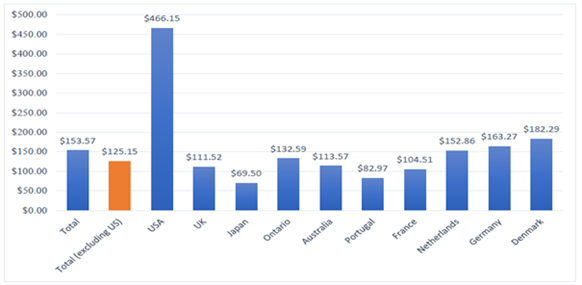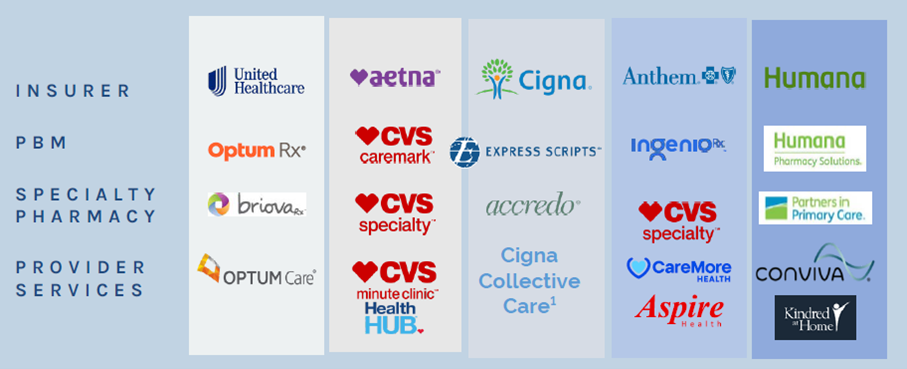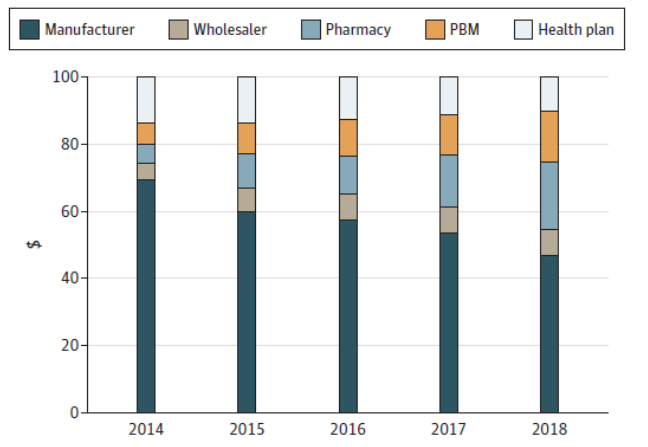
Finally! Humira’s biosimilars also hit the us market!
Humira was first marketed in 2002 and was protected in the US market until 2023, thanks to AbbVie’s use of two strategies :

Today Americans on average pay their drugs 3 to 6 times what people in other developed countries pay, as shown in the graph below.

2 different types of actors are to be incriminated: drug manufacturers and PBMs, each of them trying to shift the responsibility for this situation on the other! But in fact, both are to blame.
Speaking of drug prices, everyone knows that the major concern is about “Specialty drugs”, since generic prices on the US market are on par with other countries.
On June 7, 2022, JAMA published a study evaluating trends in prices for 548 of 576 brand-name drugs (95%)- in fact Specialty drugs, first marketed between 2008-2021.
Results are really shocking: prices for new drugs increased exponentially by 11% per year even after adjusting for estimated manufacturers’ discounts!
Median launch prices increased from $2,115 per year for the average patient in 2008 to $180,007 in 2021!

In 2020-2021, nearly half these new drugs (47%) were initially priced above $150 000 per year! (The black horizontal line in the grey box).
To make the situation worse for patients, the authors of the study found that even after drugs are marketed, manufacturers routinely increase prices over time. In another analysis, net prices for these costly drugs increased 4.5% per year from 2007 to 2018, way more than inflation rates.
The team of researchers concludes that since rising brand-name drug prices often translate to payers restricting access, raising premiums, or imposing unaffordable out-of-pocket costs for patients, the US could stop allowing drug manufacturers to freely set prices and follow the example of other industrialized countries that negotiate drug prices at launch.
Care2Care solution to this problem
To address this issue, we help patients get their drugs from Canada, and, if accepted by the plan and the patient, from other OECD countries at prices 50 to 80% lower than in the US. As everyone should know, these are the same products, sometimes manufactured in the same plants than those distributed in the US, the only difference being the price.
Scrutiny on PBM has been mounting for several years. We published in May 2022 a white paper describing their secretive bad practices, like claw backs, spread pricing, rebate aggregators located in tax havens, etc.
Year after year the 3 largest PBM (Optum, CVS caremark, EXPRESS SCRIPT) have taken control over 80% of the market.
Worse, they built an upwards integrated model with insurers, becoming their profit engine.
On the distribution side, they built their own network of Specialty pharmacies.

The situation results in misaligned incentives at the expense of patients and plan sponsors.
So for instance, a study by USC SCHAEFFER on the prices of insulin showed that instead of helping to lower prices of these lifesaving medicines, PBM ensured for themselves a larger share of the market, resulting in higher prices!
The table below shows the manufacturers’ share of revenues decreased by 33% in 5 years while PBMs and pharmacies substantially increased their piece of the pie: +228% for pharmacies and +154% for PBMs.
All the while insulin prices increased by 40%!
Average Distribution of $100 in Insulin Expenditures for 32 Insulin Products Across Distribution System Participants, 2014-2018

It’s a striking example of how deeply traditional PBMs have failed to their core value proposition to negotiate the best conditions for their clients and how dysfunctional the drug market has become.
Finally, after years of complaints from different actors (independent pharmacies, employers, Big pharma), Congress ordered the FTC to investigate 6 of the largest PBMs on their practices.
When will this study deliver conclusions? What will be done in the end to change this dire situation? Is it the real answer to all the problems Americans encounter accessing their needed medicines?
“The FTC should not give a free pass to drug manufacturers and others looking to scapegoat PBMs. Instead, the Commission should examine the entire drug distribution supply chain, including drug manufacturers, to better understand why drug prices are out of control,” AHIP wrote.
Time to remind that some actors like Care2care International and its partners already built effective solutions!
At Care2care International we want to reassure employers and their advisors that we are a “new breed” of PBM, acting solely in the best interest of our clients, with results that can be summarized in one graph.: after adopting our solution, plan sponsors will see a steep decrease in the Per Member Per Month total pharmacy cost
(PMPM is the metric we recommend to use when comparing PBM performances.)

To learn more on these complex issues, don’t hesitate to download our White Paper :

Humira was first marketed in 2002 and was protected in the US market until 2023, thanks to AbbVie’s use of two strategies :

After wrapping up the 2023 enrollment, employers are now planning their next moves to mitigate the continuously growing healthcare costs impacting their plans. This is particularly true for pharmacy costs.

PhRMA, a Big Pharma lobbying group, released an advertising touting that drug prices were not fueling inflation. To prove it, they produce the graphic below.
Care2Care secured a strategic partnership with an innovative, transparent, 100% pass-through PBM.
Adding to our expertise in international drug sourcing, we expand our offer to the full pharmacy benefit management.
